Landblog Main
previous archive
Weeds -- 21 May 2010 -- Here's an excellent Sharon Astyk post, Getting Intimate With My Weeds. She covers which ones are so good that we should plant them, how we can use them to learn about the land, and how "invasives" are mostly symptoms of human mismanagement. On my land I've noticed that both spotted knapweed and hound's tongue produce lots of nectar for the wild bees, so I only pluck the knapweed if it's growing next to something important, and I kill the hound's tongue after it flowers but before it finishes making seeds, which are terrible burrs. I've also scattered seedballs and plain seeds of dandelion, lamb's quarters, and chickweed, but none of them like to grow up there.Spring 2010 Roundup -- 26 May 2010 -- A couple weeks ago I bought three 55 gallon plastic water barrels off Craigslist for $25 each, which is not a great price, but good enough considering that they're at least $50 retail. I filled the white one with drinking water, and later I'll fill the blue ones with plant water. These are precautions in case the spring dries up after the mild winter.
On the latest trip, still lacking straw for cob, I did what I like to do best: puttered around taking care of little things. First I checked out all the plants. Last weekend we had a late frost, and I was worried that even some natives might be damaged, but I found shriveled leaves on only two plants, a black walnut and an American chestnut -- the other chestnut and walnuts hadn't leafed out yet. The cherry blossoms had brown spots but should still make cherries. [Update: the frost caused invisible damage and I only got five cherries this year.]
Blossoming for the first time were one Nanking cherry, the youngest Aronia, and the Ivan's Belle that I just planted. Ivan Michurin was a legendary Russian plant breeder, and those are two crosses he made with European mountain ash, a.k.a. Rowan, and according to the Wikipedia article at that link, it's also called a Ran tree! Anyway, Belle crosses hawthorne and Beauty crosses aronia, and both of them are looking great. Two of last year's sea buckthorns are dead, an Orange September female and the male. Most everything else is just squeaking by as usual. The Ashmead's apple is putting on some nice growth in its second spring after being broken to the ground on two consecutive winters.
My big project on this trip was trying to get the lower spring pool to hold water. It used to hold it fine, but I must have dug too deep because all the water started leaking out the bottom. I tried coating it with clay, and then throwing a bag of leaves in, which just made it smell like a sewer. Then I saw a Sepp Holzer video on exactly the same subject, and I sat through ten minutes of rambling to get the half minute point: He watched pigs seal ponds, experimented to imitate them, and discovered that the trick is lots of wet tamping. So I added more clay and silt, and tamped it in hard with my bare feet and a small log. It's better now but still needs work. I also think the pigs add manure which creates a biological membrane called a gley. Because my pool is small, the rotting leaves might be enough. If not, I'll rot a layer of manure under plastic.
Straw Season -- 28 May 2010 -- According to The Hand-Sculpted House, the best straw for cob is oat, rye, or winter wheat, and I expect that winter wheat is the most common. Here's a page that shows planting and harvest dates for wheat. In eastern Washington, winter wheat will not be harvested until July, which means if I want it in May, I have to buy bales stored since last summer. On Spokane Craigslist this month there are more people looking for straw than selling it, and I just drove nearly an hour each way to buy three mediocre bales for $5 each. This is why I'm starting with a shed, so I can use up some mistakes on a structure that's not that important.
Digging -- 1 June 2010 -- I unloaded and checked out the straw bales, and they are inadequate for cob. The stalks are short and weak, and at some point before I got them they were left out in the rain, and now they're rotting. I can still use them for compost, but the cob project will have to wait. That's okay because there's plenty of other stuff I can do. On this trip, with all the rain, I did lots of digging.
I was thinking the north hill had bedrock close enough to the surface that I could build a cabin straight on the rock, and save the considerable trouble of assembling eight tons of rocks for a foundation. But a test hole got deeper and deeper and killed that plan. So far all the holes I've dug have been the same: one to six inches of topsoil, six to twelve inches of silt, and then sand as far as I can dig. That means, once I get through the silt, the digging is easy. It also explains why many plants don't like to grow up there. They would need both shallow roots to get nutrients from the topsoil, and deep roots to get water in the dry summers.
Anyway, this is the time to figure out every place that I might want to dig this year, and get through the silt while it's still soft.
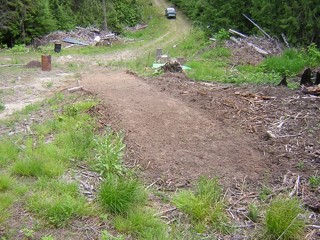 Tamping and Sawing -- 10 June 2010 -- This was my big project on this trip, a vehicle ramp coming to the top of where the giant slash pile used to be. It took only an hour with a shovel to rough this out, and then several hours of raking and tamping to get it to this stage, and after this photo, I tried backing the truck to the top, and discovered that it still needs more tamping, since most of it is resting on fill. Bob donated a homemade tamper, a length of heavy pipe welded to a square foot of thick metal, but the weld is broken and it's barely holding together, so I'm mostly using myself as the tamper. I figure that I can stomp my own 145 pounds with more force than I can lift and push down a 50 pound object, although I can't spread it out as much. And then I can always drive the truck up and down.
Tamping and Sawing -- 10 June 2010 -- This was my big project on this trip, a vehicle ramp coming to the top of where the giant slash pile used to be. It took only an hour with a shovel to rough this out, and then several hours of raking and tamping to get it to this stage, and after this photo, I tried backing the truck to the top, and discovered that it still needs more tamping, since most of it is resting on fill. Bob donated a homemade tamper, a length of heavy pipe welded to a square foot of thick metal, but the weld is broken and it's barely holding together, so I'm mostly using myself as the tamper. I figure that I can stomp my own 145 pounds with more force than I can lift and push down a 50 pound object, although I can't spread it out as much. And then I can always drive the truck up and down.Also I've started cutting down trees. A six inch diameter grand fir was just killed by some kind of critter that eats away under the bark. The needles at the top of the tree are red but haven't fallen off yet. Like a lot of the trees I'm cutting, it was stuck in other trees at the top, so after I cut it, it leaned a bit and I left it to fall on its own, and it came down in the rain the next morning.
The Faucet Job -- 16 June 2010 -- Back in May 2007 I did the spring job, where I installed a copper pipe, catching the water where it comes up at the bottom of the spring pool, and carrying it 15 feet to come out of the hillside below. Since then, I've had a raw half inch pipe drizzling water constantly, down rocks into the lower pool. To fill drinking water containers, I would just set them on the rocks. The problem was, the flow would gradually decrease, probably because of the collector getting clogged with silt, and I would have to blow air through to clear it -- and then it would flow too fast and deplete the upper pool.
 Here's the solution. The pipe in this photo is just for illustration -- the actual pipe is sticking out of the side of the hill. I sanded the cork down to fit in the pipe and stop the water flow. Above are the flux and lead-free solder for the joint. I could have soldered the faucet straight onto the pipe, but Charlie pointed out that the heat could damage the faucet, so instead I could solder on the intermediate copper piece and then screw the faucet on later.
Here's the solution. The pipe in this photo is just for illustration -- the actual pipe is sticking out of the side of the hill. I sanded the cork down to fit in the pipe and stop the water flow. Above are the flux and lead-free solder for the joint. I could have soldered the faucet straight onto the pipe, but Charlie pointed out that the heat could damage the faucet, so instead I could solder on the intermediate copper piece and then screw the faucet on later.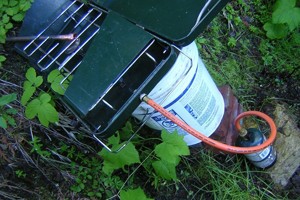 Another problem was that I didn't have a torch. So my plan was to plug the pipe with the cork, and then stack up bricks and a five gallon bucket to hold my two-burner propane camp stove right under the joint. Then after soldering the joint, I would use a drill to take the cork out. Can you guess where the plan went wrong?
Another problem was that I didn't have a torch. So my plan was to plug the pipe with the cork, and then stack up bricks and a five gallon bucket to hold my two-burner propane camp stove right under the joint. Then after soldering the joint, I would use a drill to take the cork out. Can you guess where the plan went wrong?It's surprisingly easy to solder a pipe with a camp stove, and surprisingly hard to get a cork out of a pipe with a drill bit. The cork fragments just got stuck deeper, and after all that work to avoid taking the pipe out of the hill, I had to take the pipe out of the hill. [Update: Chris writes that instead of a cork, you can use balled-up Wonder Bread! "It seals tight, but only temporarily."]
 Luckily, the pipe segments under the ground were joined with an unsoldered coupling, so all I had to do was pull out the last five foot section, use two dried great mullein stalks to push the cork out, jam the pipe back in ground, and then dig a muddy hole to reconnect it. Obviously, I should have done that from the beginning.
Luckily, the pipe segments under the ground were joined with an unsoldered coupling, so all I had to do was pull out the last five foot section, use two dried great mullein stalks to push the cork out, jam the pipe back in ground, and then dig a muddy hole to reconnect it. Obviously, I should have done that from the beginning.Anyway, you can see here that it works. Bob donated the rock slabs, which make it easier to fill containers. The only disadvantage is that the water splatters now instead of coming down in a smooth stream. But because I only use it when I need it, I can always have a fast flow (almost a gallon a minute) without draining the upper pool. And once I get the lower pool to hold water, I want to put in an overflow pipe from the top of the upper pool, to take the water straight to the lower pool instead of letting most of it soak into the ground.
Early Summer Odds and Ends -- 2 July 2010 -- For all the time I'm spending on the land, I'm not getting a lot done. Solo homesteading is really hard! Not only do I have to do work to water plants and dig holes -- I also have to do work to make the food to give myself the energy to do work, to move the solar oven around, to wash dishes, to freshen the water in the cooler, to brush the dirt out of the tent, to carry scraps to the compost bin. I don't even have to grow or hunt or forage the food I eat, and I'm already barely above the break-even point. It would be much easier if I was part of a small group, where one person could take care of cooking and cleaning for everyone... or if I had three stomachs and could just munch thimbleberry leaves all day to fuel myself.
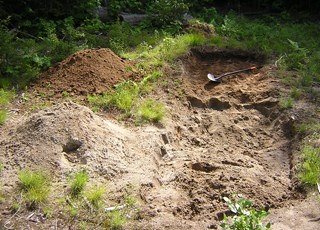 One thing I've discovered is that I love digging! In this picture you can see a pile of sand, a pile of brown silt, and in the background, a pile of topsoil. Later I made two more piles of sand and brown silt from digging a burning pit, a pile of red silt, and another huge pile of topsoil and good silty loam, from underneath where I've been throwing compost for five years.
One thing I've discovered is that I love digging! In this picture you can see a pile of sand, a pile of brown silt, and in the background, a pile of topsoil. Later I made two more piles of sand and brown silt from digging a burning pit, a pile of red silt, and another huge pile of topsoil and good silty loam, from underneath where I've been throwing compost for five years.Because of the rainy spring, all the native plants are growing extra this year. I spent a couple hours just trimming back the thimbleberry and snowberry and ocean spray and bracken ferns that are closing in above my trails and food plants. It seems like the bracken can grow a foot a day. Also I made a new trail, a cutoff from the tent to the outhouse. Between that and the ex-compost pit, I got so much oregon grape root, that soaking it all for tincture consumed an entire 1.75 liter bottle of vodka.
My plants are doing well, except the peach, which got leaf curl from the wet weather, and the black walnuts, which have always walked the edge of death. Because the late frost damaged the cherry blossoms, the big tree is only going to make five cherries this year. The Orus 8 gooseberry/currant, and the Ivan's Belle, are both producing berries their first year. One of the new paw paws is dead, and I transplanted another one that was in the way of a future project. Normally you can't transplant paw paws but the roots hadn't grown enough yet to be shocked.
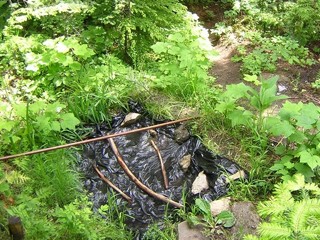 Another little project was to make an overflow pipe for the spring pool. Here you can see the new pipe suspended above the lower spring pool, which is now drained of water, and coated with horse manure and garbage bags. This is to create a "gley", a layer of anaerobically-decayed organic matter to stop water from leaking out. Until it's sealed, I've closed the new faucet, which drains from the bottom of the upper pool. So now the upper pool is overflowing, and the water is drizzling down the slope and soaking into the ground. I want to send the water down below the lower spring pool, to begin to create a stream course. So I picked out two ten foot copper pipes, a half inch (not shown) and a three quarter inch. The half inch pipe starts from the edge of the upper pool. It's held in place by nothing but the friction of having a foot of its length shallowly buried in dirt. Then the lower end of the half inch pipe fits inside the upper end of the three quarter inch pipe, and the lower end of that pipe rests on a rock to keep it from sliding down the hill, while the rigidity of the two pipes keeps them together. This is the sketchiest thing I've done up there that has actually worked.
Another little project was to make an overflow pipe for the spring pool. Here you can see the new pipe suspended above the lower spring pool, which is now drained of water, and coated with horse manure and garbage bags. This is to create a "gley", a layer of anaerobically-decayed organic matter to stop water from leaking out. Until it's sealed, I've closed the new faucet, which drains from the bottom of the upper pool. So now the upper pool is overflowing, and the water is drizzling down the slope and soaking into the ground. I want to send the water down below the lower spring pool, to begin to create a stream course. So I picked out two ten foot copper pipes, a half inch (not shown) and a three quarter inch. The half inch pipe starts from the edge of the upper pool. It's held in place by nothing but the friction of having a foot of its length shallowly buried in dirt. Then the lower end of the half inch pipe fits inside the upper end of the three quarter inch pipe, and the lower end of that pipe rests on a rock to keep it from sliding down the hill, while the rigidity of the two pipes keeps them together. This is the sketchiest thing I've done up there that has actually worked. Wall Tent Mosquito Fix -- 21 July 2010 -- Peak mosquito season has begun. There is still enough standing water around for them to breed, and it's warm enough now that they're active all night. The first evening inside the wall tent, I spent half an hour killing every one that came in, then another half hour totally covered by the sleeping bag except for an air hole, listening to them buzz around and sometimes seeing them come in the hole. Then I went and slept in the truck.
When I anticipated this problem a few months ago, readers suggested many ideas for attaching the tent walls to the platform with no room for mosquitoes to get in. The most popular was strips of wood screwed to the edge of the platform through the vinyl sod cloth, which hangs past the edge. This would be easy enough at the back of the tent, but much more difficult on the sides, where the ends of the boards are not perfectly even. And it wouldn't work on the front, where the door has to open and close. I tried "industrial strength" velcro tape, but it doesn't stick that well to wood, and barely at all to canvas, which is necessary to block the gap right under the door.
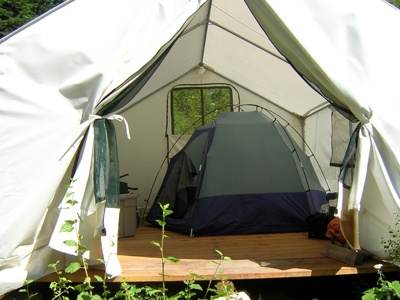 Then I figured it out! It didn't cost me anything, because I already had this in storage up there, and it only took 20 minutes to set it up. I think this is an L.L. Bean tent that I bought for a road trip in 1990. The mattress barely fits inside, and at bedtime I can just climb in and zip it up.
Then I figured it out! It didn't cost me anything, because I already had this in storage up there, and it only took 20 minutes to set it up. I think this is an L.L. Bean tent that I bought for a road trip in 1990. The mattress barely fits inside, and at bedtime I can just climb in and zip it up.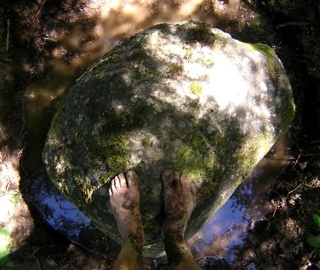 My Empire of Water -- 29 July 2010 -- When I bought the land six years ago, I had a dream the very next night that it was covered with streams and pools of flowing water. That seemed unlikely, because summers up there are so dry. But there's a lot of winter snow, so one of my first projects was to dig little basins along the runoff lines, to make pools of water or at least soak it into the ground instead of losing it downstream.
My Empire of Water -- 29 July 2010 -- When I bought the land six years ago, I had a dream the very next night that it was covered with streams and pools of flowing water. That seemed unlikely, because summers up there are so dry. But there's a lot of winter snow, so one of my first projects was to dig little basins along the runoff lines, to make pools of water or at least soak it into the ground instead of losing it downstream.It turns out the soil is so sandy that almost all the water soaks into the ground anyway... and most of it flows away underground, possibly into aquifers from which it's pumped up to water lawns and flush toilets. So now my goal is to stop it from soaking in. More precisely, I want the heavy rain and snow to soak into the hills, which act as giant holding tanks, letting it out slowly from springs at the bottom. Then I want the water from those springs to flow on the surface all through the low areas, all through the summer.
The photo above is the best success I've had so far. Originally the water from the big spring pool just drizzled over the edge and soaked back into the ground. I put in a pipe and a lower pool to catch and hold it, but I dug too deeply and it all leaked out the bottom. Now, while I'm trying to seal the lower pool, I've got another pipe taking the overflow from the big pool farther down the hill, where it trickles through a few pools just big enough to cool a soda can, into what I call the moat.
For coaxing a trickle of water into a stream, my technique is very simple, and I'm sure millions of people through the ages have figured this out: Wherever the water is, stomp and pack the ground under it, and then wherever it goes, stomp again, and so on.
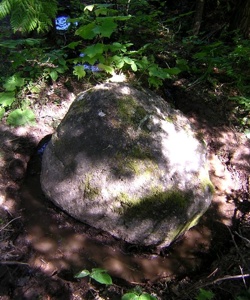 I figured the moat was far enough for this year. But last Sunday night, between the two hottest days of the year, I dreamed that a heavy flow from the spring allowed me to fill another two pools. Monday afternoon I found the whole course dried up. This happens when the overflow intake gets plugged, so I cleared it out, and since the water had risen a bit, the flow was very heavy for a few minutes.
I figured the moat was far enough for this year. But last Sunday night, between the two hottest days of the year, I dreamed that a heavy flow from the spring allowed me to fill another two pools. Monday afternoon I found the whole course dried up. This happens when the overflow intake gets plugged, so I cleared it out, and since the water had risen a bit, the flow was very heavy for a few minutes.What the hell... with my hands and feet, I dug and stomped a channel at the back of the moat, a shallow pool, and another channel, and extended the stream by two pools. Of course they both dried up when the flow went back to normal, but next April they should be overflowing and I can keep going. Then I want to experiment with clay and rotted organic matter to improve the seal along the whole course.
Meanwhile, much farther down, there is a swampy area fed by a second spring. Last year I dug a pool big enough to dip five gallon buckets, which has been a big help. And on the latest trip I cleared branches and bracken from the water course below the pool, to enable walking and tamping. Then the water disappears under a giant slash pile. To be continued...